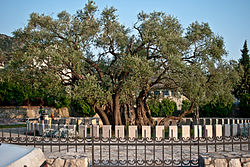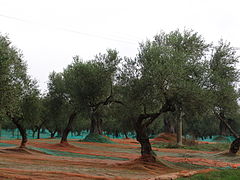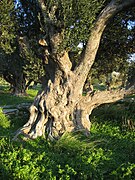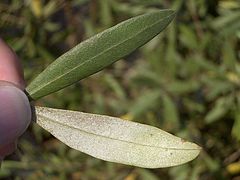Маслина — разлика између измена
. ознака: везе до вишезначних одредница |
|||
| Ред 7: | Ред 7: | ||
| genus = Olea |
| genus = Olea |
||
| species = europaea |
| species = europaea |
||
| status = DD |
|||
| status_system = IUCN3.1 |
|||
| status_ref = <ref>{{cite web |last1=Magos Brehm |first1=J. |last2=Draper Munt |first2=D. |last3=Kell |first3=S.P. |date=2011 |title=''Olea europaea'' (errata version published in 2016) |work=The [[IUCN Red List]] of Threatened Species 2011 |version=e.T63005A102150835 |access-date=26 June 2021 |url=http://www.iucnredlist.org/species/63005/102150835}}</ref> |
|||
| authority = [[Карл фон Лине|-{L.}-]] |
| authority = [[Карл фон Лине|-{L.}-]] |
||
| range_map = Olea europaea range.svg |
| range_map = Olea europaea range.svg |
||
| range_map_caption = Мапа дистрибуције |
| range_map_caption = Мапа дистрибуције |
||
}} |
}} |
||
{{рут}} |
|||
'''Маслина''', '''маслинка''', '''маслица''', '''уљица''', '''уљеника''' или '''олива''' ({{јез-лат|Olea europaea}}) је врста ниског [[дрво|дрвета]] која потиче из источног [[Средоземно море|Медитерана]] и припада истоименој фамилији (-{[[Oleaceae]]}-). |
'''Маслина''', '''маслинка''', '''маслица''', '''уљица''', '''уљеника''' или '''олива''' ({{јез-лат|Olea europaea}}) је врста ниског [[дрво|дрвета]] која потиче из источног [[Средоземно море|Медитерана]] и припада истоименој фамилији (-{[[Oleaceae]]}-). The species is cultivated in all the countries of the [[Mediterranean Sea|Mediterranean]], as well as in Australia, New Zealand, North and South America and South Africa.<ref>{{cite web |url=http://apps.kew.org/wcsp/namedetail.do?name_id=355112 |title=Kew World Checklist of Selected Plant Families, Olea europaea |publisher=[[Royal Botanic Gardens, Kew]] |access-date=December 5, 2014 }}</ref><ref>{{cite web |url=http://bonap.net/MapGallery/County/Olea%20europaea.png |publisher=Biota of North America Program |title=''Olea europaea'' (map) |access-date=December 5, 2014 }}</ref> |
||
== Опис биљке == |
== Опис биљке == |
||
[[Датотека:Olea_europaea_-_Köhler–s_Medizinal-Pflanzen-229.jpg|мини|лево|Лист, цвет и плод маслине]] |
[[Датотека:Olea_europaea_-_Köhler–s_Medizinal-Pflanzen-229.jpg|мини|лево|250п|Лист, цвет и плод маслине]] |
||
Зимзелено дрво које расте у [[Средоземно море|Средоземљу]] где се уље, које се добија прерадом плодова ове биљке, сматра симболом медитеранског начина исхране. Истовремено је и симбол мира, плодности, изобиља и дуговечности. Листови су елиптични, дугуљасти, кожасти са тамнозеленим лицем и сребрнастосивим наличјем и врло кратком дршком. Из пазуха листова развијају се усправне гроздасте цвасти које чине цветови са белом круницом. Чашица и круница имају по 4 листића. Плод је јестива коштуница, позната као [[маслина|маслинка]], тамноплаве до скоро црне боје и од њега се добија чувено [[маслиново уље]]. |
Зимзелено дрво које расте у [[Средоземно море|Средоземљу]], Азији и Африци, где се уље, које се добија прерадом плодова ове биљке, сматра симболом медитеранског начина исхране. Истовремено је и симбол мира, плодности, изобиља и дуговечности. Листови су елиптични, дугуљасти, кожасти са тамнозеленим лицем и сребрнастосивим наличјем и врло кратком дршком. Из пазуха листова развијају се усправне гроздасте цвасти које чине цветови са белом круницом. Чашица и круница имају по 4 листића. Плод је јестива коштуница, позната као [[маслина|маслинка]], тамноплаве до скоро црне боје и од њега се добија чувено [[маслиново уље]]. |
||
It is short and squat and rarely exceeds {{convert|8|-|15|m|ft|abbr=on|round=5}} in height. 'Pisciottana', a unique variety comprising 40,000 trees found only in the area around [[Pisciotta]] in the [[Campania]] region of southern Italy, often exceeds this, with correspondingly large trunk diameters. The silvery green [[leaf|leaves]] are oblong, measuring 4–10 cm long and 1–3 cm wide. The trunk is typically gnarled and twisted.<ref>{{cite book|author1=Eddo Rugini|author2=Luciana Baldoni|author3=Rosario Muleo|author4=Luca Sebastiani|title=The Olive Tree Genome|url=https://books.google.com/books?id=DgDGDQAAQBAJ&pg=PA14+|year=2016|publisher=Springer|isbn=978-3-319-48887-5|page=14}}</ref> |
|||
The fruit is a small [[drupe]] 1–2,5 cm long when ripe, thinner-fleshed and smaller in wild plants than in orchard cultivars. Olives are harvested in the green to purple stage.<ref>{{cite book |url=https://books.google.com/books?id=iBsmDwAAQBAJ&pg=PA129 |page=129 |title=Olives and Olive Oil as Functional Foods: Bioactivity, Chemistry and Processing |editor1=Apostolos Kiritsakis |editor2=Fereidoon Shahidi |publisher=[[John Wiley & Sons]] |date=2017|isbn=978-1-119-13531-9}}</ref> ''Olea europaea'' contains a [[pyrena]] commonly referred to in American English as a "pit", and in British English as a "stone".<ref>{{cite book |url=https://books.google.com/books?id=J7gfBQAAQBAJ&pg=PA113|page=113 |title=A Complete Course in Canning and Related Processes: Volume 3 Processing Procedures for Canned Food Products |author=Susan Featherstone |publisher=Woodhead Publishing |date=2015|isbn=978-0-85709-687-6}}</ref> |
|||
== Таксономија == |
|||
The six natural subspecies of ''Olea europaea'' are distributed over a wide range:<ref name=j2/><ref name=j3/><ref>{{cite journal | url = https://www.researchgate.net/publication/226023886 | title = Genetic characterisation of olive trees from Madeira Archipelago using flow cytometry and microsatellite markers | journal = Genetic Resources and Crop Evolution | year = 2008}}</ref> |
|||
*''Olea europaea'' subsp. ''europaea'' (Mediterranean Basin) |
|||
The subspecies ''europaea'' is divided into two [[variety (botany)|varieties]], the ''europaea'', which was formerly named ''Olea sativa'', with the [[seedling]]s called "olivasters", and ''silvestris'', which corresponds to the old wildly growing Mediterranean species ''[[Olea oleaster]]'', with the seedlings called "oleasters".<ref>{{cite journal |url=https://www.researchgate.net/publication/315747227 |title=Oleiculture in progress |first1=Elettra |last1=Marone |first2=Piero |last2=Fiorino |date=January 2012 |journal=Advances in Horticultural Science |volume=26 |issue=3–4 |doi=10.13128/ahs-22672}}</ref> The ''sylvestris'' is characterized by a smaller tree bearing noticeably smaller fruit. |
|||
*[[Olea europaea subsp. cuspidata|''O. e.'' subsp. ''cuspidata'']] (from South Africa throughout East Africa, [[Arabian Peninsula|Arabia]] to [[Southwest China]]) |
|||
*''O. e.'' subsp. ''cerasiformis'' ([[Madeira]]); also known as ''Olea maderensis'' |
|||
*''O. e.'' subsp. ''guanchica'' (Canary Islands) |
|||
*''O. e.'' subsp. ''laperrinei'' (Algeria, Sudan, Niger) |
|||
*''O. e.'' subsp. ''maroccana'' (Morocco) |
|||
The subspecies ''O. e. cerasiformis'' is [[Polyploidy|tetraploid]], and ''O. e. maroccana'' is hexaploid.<ref name=j5/> Wild-growing forms of the olive are sometimes treated as the species ''[[Olea oleaster]]'', or "oleaster." The trees referred to as "[[Canarium album|white]]" and "[[Canarium pimela|black]]" olives in Southeast Asia are not actually olives but species of ''[[Canarium]]''.<ref>{{Cite web |url=https://www.nparks.gov.sg/gardens-parks-and-nature/heritage-trees/ht-2005-136 |title=Buah Ca-na, Chinese White Olive |website=Singapore National Parks Board |language=en |access-date=2019-02-14}}</ref> |
|||
===Cultivars=== |
|||
{{Main|List of olive cultivars}} |
|||
Hundreds of cultivars of the olive tree are known.<ref name="encyclopedia1996">{{citation|title=World Olive Encyclopedia|publisher=[[International Olive Council]]|year=1996|isbn=978-8401618819}}</ref><ref>{{cite book|author=Lanza, Fabrizia |title=Olive: A Global History|year=2012|publisher=Reaktion Books|isbn=978-1-86189-972-9|pages=106–110}}</ref> An olive's cultivar has a significant impact on its color, size, shape, and growth characteristics, as well as the qualities of olive oil.<ref name="encyclopedia1996"/> Olive cultivars may be used primarily for oil, eating, or both. Olives cultivated for consumption are generally referred to as "table olives".<ref name="Fernández, A. Garrido 1997">{{cite book|author1=Garrido Fernandez, A. |author2=Fernandez-Diez, M.J. |author3=Adams, M.R. |title=Table Olives: Production and Processing|year=1997|publisher=Springer|isbn=978-0-412-71810-6|pages=23–45}}</ref> |
|||
== Историја == |
|||
===Mediterranean Basin=== |
|||
Fossil evidence indicates the olive tree had its origins 20–40 million years ago in the [[Oligocene]], in what is now corresponding to Italy and the eastern Mediterranean Basin.<ref name="Therios">{{cite book |title=Olive Oil. Chemistry and Technology |editor-last=Boskou |editor-first=D. |publisher=AOCS Press |date=1996 }}</ref><ref>{{Cite book|url=https://books.google.com/books?id=dXqXXeHI_PcC&pg=PA1|title=Olives: Volume 18 of Crop Production Science in Horticulture (History of Olive Growing, page 1)|last=Therios|first=Ioannis Nikolaos|date=2009|publisher=CABI|isbn=978-1-84593-620-4}}</ref> Around 100,000 years ago, olives were used by humans in Africa, on the Atlantic coast of Morocco, for fuel management and most probably for consumption.<ref>{{Cite journal |last1=Marquer |first1=L. |last2=Otto |first2=T. |last3=Arous |first3=E. Ben |last4=Stoetzel |first4=E. |last5=Campmas |first5=E. |last6=Zazzo |first6=A. |last7=Tombret |first7=O. |last8=Seim |first8=A. |last9=Kofler |first9=W. |last10=Falguères |first10=C. |last11=El Hajraoui |first11=M. Abdeljalil |date=2022-03-22 |title=The first use of olives in Africa around 100,000 years ago |url=https://www.nature.com/articles/s41477-022-01109-x |journal=Nature Plants |language=en |volume=8 |issue=3 |pages=204–208 |doi=10.1038/s41477-022-01109-x |pmid= |s2cid= |issn=2055-0278}}</ref> Wild olive trees, or oleasters, were present and collected in the [[Eastern Mediterranean]] since ~19,000 BP.<ref>Kislev et al. 1992</ref> The [[genome]] of cultivated olives reflects their origin from oleaster populations in the Eastern Mediterranean.<ref>Besnard et al. 2002,2013b</ref><ref>Lumaret et al. 2004</ref><ref>Baldoni et al. 2006</ref><ref>Diez et al. 2015</ref><ref>{{cite book |last1=Thompson |first1=John D. |title=Plant Evolution in the Mediterranean: Insights for Conservation |date=2020 |publisher=Oxford University Press |isbn=9780198835141 |url=https://books.google.com/books?id=lxT0DwAAQBAJ}}</ref> The olive plant was first cultivated some 7,000 years ago in Mediterranean regions.<ref name=Therios/><ref>{{cite book |last=Di Giovacchino |first=Luciano |title=Handbook of Olive Oil: Analysis & Properties |edition=2nd |publisher=Springer Science & Business Media |location=New York |year=2013 |chapter=3 |page=57 }}</ref> |
|||
For thousands of years olives were grown primarily for lamp oil, with little regard for culinary flavor.<ref name="vossen">{{cite journal |last=Vossen |first=Paul |title=Olive Oil: History, Production, and Characteristics of the World's Classic Oils |journal=HortScience |year=2007 |volume=42 |issue=5 |pages=1093–1100|doi=10.21273/HORTSCI.42.5.1093 |doi-access=free }}</ref> Its origin can be traced to the [[Levant]] based on written tablets, olive pits, and wood fragments found in ancient tombs.<ref name="vossen"/><ref>{{cite book |last=Lanza |first=Fabrizia |title=Olive: a global history |year=2011 |publisher=Reaktion Books|isbn=978-1-86189-972-9|location=London |page=15 }}</ref> As far back as 3000 BC, olives were grown commercially in [[Crete]]; they may have been the source of the wealth of the [[Minoan civilization]].<ref name="gooch">{{cite journal |last=Gooch |first=Ellen |url=http://www.epikouria.com/issue1/10+1-things-olives.php |title=10+1 Things you may not know about olive oil |journal=Epikouria Magazine |issue=Fall/Spring |year=2005 |access-date=December 5, 2014 |archive-url=https://web.archive.org/web/20141208032145/http://www.epikouria.com/issue1/10+1-things-olives.php |archive-date=December 8, 2014 |url-status=dead }}</ref> |
|||
The ancestry of the cultivated olive is unknown. Fossil ''[[olea]]'' pollen has been found in [[Macedonia (region)|Macedonia]] and other places around the Mediterranean, indicating that this genus is an original element of the Mediterranean flora. Fossilized leaves of ''olea'' were found in the [[paleosol|palaeosols]] of the volcanic Greek island of [[Santorini]] and dated to about 37,000 [[Before Present|BP]]. Imprints of larvae of olive [[whitefly]] ''[[List of whitefly species|Aleurobus olivinus]]'' were found on the leaves. The same insect is commonly found today on olive leaves, showing that the plant-animal co-evolutionary relations have not changed since that time.<ref>Friedrich W.L. (1978). [http://www.therafoundation.org/articles/environmentflorafauna/fossilplantsfromweichselianinterstadialssantorinigreeceii Fossil plants from Weichselian interstadials, Santorini (Greece) II], published in the "Thera and the Aegean World II", London, pp. 109–128. Retrieved on 2011-12-07.</ref> Other leaves found on the same island are dated back to 60,000 BP, making them the oldest known olives from the Mediterranean.<ref>{{Cite web|url=http://www.oliveoilmuseums.gr/ecportal.asp?id=55&nt=18&lang=2|title=Mediterranean Museums of Olive|website=www.oliveoilmuseums.gr|access-date=2016-05-22|archive-date=2016-02-08|archive-url=https://web.archive.org/web/20160208070740/http://www.oliveoilmuseums.gr/ecportal.asp?id=55&nt=18&lang=2|url-status=dead}}</ref> |
|||
== Лековити састојци == |
== Лековити састојци == |
||
| Ред 148: | Ред 186: | ||
== Галерија == |
== Галерија == |
||
<gallery> |
<gallery widths="250px" heights="180px"> |
||
Слика:Oliva in Bar.jpg|У Црној Гори, у Бару, расте [[Стара маслина]] (''Olea europaea'') чија се старост процењује на преко 2.000 година. Верује се да је ово најстарије стабло маслине у Европи и једно од најстаријих у свету |
Слика:Oliva in Bar.jpg|У Црној Гори, у Бару, расте [[Стара маслина]] (''Olea europaea'') чија се старост процењује на преко 2.000 година. Верује се да је ово најстарије стабло маслине у Европи и једно од најстаријих у свету |
||
Слика:Kalabrien Oliven 2257.jpg|Маслињак |
Слика:Kalabrien Oliven 2257.jpg|Маслињак |
||
| Ред 165: | Ред 203: | ||
== Референце == |
== Референце == |
||
{{reflist |
{{reflist|refs= |
||
<ref name=j2>{{cite journal|author=Green PS |year=2002|title=A revision of Olea L. (Oleaceae) |journal=Kew Bulletin |volume=57|pages=91–140|jstor=4110824|doi=10.2307/4110824|issue=1}}</ref> |
|||
<ref name=j3>{{cite journal|vauthors=Besnard G, Rubio de Casas R, Christin PA, Vargas P |title=Phylogenetics of Olea (Oleaceae) based on plastid and nuclear ribosomal DNA sequences: Tertiary climatic shifts and lineage differentiation times|doi=10.1093/aob/mcp105|year=2009|journal=Annals of Botany|volume=104|pages=143–160|pmid=19465750|issue=1|pmc=2706730}}</ref> |
|||
<ref name=j5>{{cite journal|vauthors=Besnard G, Garcia-Verdugo C, Rubio de Casas R, Treier UA, Galland N, Vargas P |title=Polyploidy in the Olive Complex (''Olea europaea''): Evidence from Flow Cytometry and Nuclear Microsatellite Analyses|doi=10.1093/aob/mcm275|year=2008|journal=Annals of Botany|volume=101|pages=25–30|pmid=18024415|issue=1|pmc=2701839}}</ref> |
|||
}} |
|||
== Литература == |
== Литература == |
||
{{refbegin|30em}} |
|||
* Гостушки, Р: Лечење лековитим биљем, Народна књига, Београд, 1979. |
* Гостушки, Р: Лечење лековитим биљем, Народна књига, Београд, 1979. |
||
* Грлић, Љ: Енциклопедија самониклог јестивог биља, Аугуст Цесарец, Загреб, 1986. |
* Грлић, Љ: Енциклопедија самониклог јестивог биља, Аугуст Цесарец, Загреб, 1986. |
||
| Ред 181: | Ред 227: | ||
* Стаменковић, В: Наше нешкодљиве лековите биљке, Тренд, Лесковац |
* Стаменковић, В: Наше нешкодљиве лековите биљке, Тренд, Лесковац |
||
* Туцаков, Ј: Лечење биљем, Рад, Београд, 1984. |
* Туцаков, Ј: Лечење биљем, Рад, Београд, 1984. |
||
{{refend}} |
|||
== Спољашње везе == |
== Спољашње везе == |
||
| Ред 196: | Ред 244: | ||
* [https://www.researchgate.net/publication/261005349_Modelizacin_del_ciclo_fenolgico_reproductor_del_olivo_%28Olea_europaea_L.%29?ev=prf_pub ''Olea europaea'' ssp. ''europaea'' (Olive Scientific Information)] |
* [https://www.researchgate.net/publication/261005349_Modelizacin_del_ciclo_fenolgico_reproductor_del_olivo_%28Olea_europaea_L.%29?ev=prf_pub ''Olea europaea'' ssp. ''europaea'' (Olive Scientific Information)] |
||
* [http://www.theolivesgift.com/the-reproduction-of-the-olive-tree/ Reproduction of the olive tree] {{Wayback|url=http://www.theolivesgift.com/the-reproduction-of-the-olive-tree/ |date=20170613100219 }} |
* [http://www.theolivesgift.com/the-reproduction-of-the-olive-tree/ Reproduction of the olive tree] {{Wayback|url=http://www.theolivesgift.com/the-reproduction-of-the-olive-tree/ |date=20170613100219 }} |
||
* [https://npgsweb.ars-grin.gov/gringlobal/taxonomydetail.aspx?25555 Agricultural Research Service, US Department of Agriculture; Germplasm Resources Information Network (GRIN): ''Olea europaea''] |
|||
* [https://www.ginartoleas.com/productos/oleas-olivos/ Most Common Spanish Olea Trees, Ginart Oleas] |
|||
{{Taxonbar}} |
{{Taxonbar|from=Q37083}} |
||
{{Authority control}} |
|||
[[Категорија:Маслина]] |
[[Категорија:Маслина]] |
||
Верзија на датум 23. фебруар 2023. у 19:19
| Маслина Временски распон: Касни плеистоцен до данас,
| |
|---|---|

| |
| Olea europaea у близини Мртвог мора, Јордан | |
| Научна класификација | |
| Царство: | Plantae |
| Кладус: | Tracheophytes |
| Кладус: | Angiospermae |
| Кладус: | Eudicotidae |
| Кладус: | Asterids |
| Ред: | Lamiales |
| Породица: | Oleaceae |
| Род: | Olea |
| Врста: | O. europaea
|
| Биномно име | |
| Olea europaea | |

| |
| Мапа дистрибуције | |
Један корисник управо ради на овом чланку. Молимо остале кориснике да му допусте да заврши са радом. Ако имате коментаре и питања у вези са чланком, користите страницу за разговор.
Хвала на стрпљењу. Када радови буду завршени, овај шаблон ће бити уклоњен. Напомене
|
Маслина, маслинка, маслица, уљица, уљеника или олива (лат. Olea europaea) је врста ниског дрвета која потиче из источног Медитерана и припада истоименој фамилији (Oleaceae). The species is cultivated in all the countries of the Mediterranean, as well as in Australia, New Zealand, North and South America and South Africa.[2][3]
Опис биљке

Зимзелено дрво које расте у Средоземљу, Азији и Африци, где се уље, које се добија прерадом плодова ове биљке, сматра симболом медитеранског начина исхране. Истовремено је и симбол мира, плодности, изобиља и дуговечности. Листови су елиптични, дугуљасти, кожасти са тамнозеленим лицем и сребрнастосивим наличјем и врло кратком дршком. Из пазуха листова развијају се усправне гроздасте цвасти које чине цветови са белом круницом. Чашица и круница имају по 4 листића. Плод је јестива коштуница, позната као маслинка, тамноплаве до скоро црне боје и од њега се добија чувено маслиново уље.
It is short and squat and rarely exceeds 8—15 m (25—50 ft) in height. 'Pisciottana', a unique variety comprising 40,000 trees found only in the area around Pisciotta in the Campania region of southern Italy, often exceeds this, with correspondingly large trunk diameters. The silvery green leaves are oblong, measuring 4–10 cm long and 1–3 cm wide. The trunk is typically gnarled and twisted.[4]
The fruit is a small drupe 1–2,5 cm long when ripe, thinner-fleshed and smaller in wild plants than in orchard cultivars. Olives are harvested in the green to purple stage.[5] Olea europaea contains a pyrena commonly referred to in American English as a "pit", and in British English as a "stone".[6]
Таксономија
The six natural subspecies of Olea europaea are distributed over a wide range:[7][8][9]
- Olea europaea subsp. europaea (Mediterranean Basin)
The subspecies europaea is divided into two varieties, the europaea, which was formerly named Olea sativa, with the seedlings called "olivasters", and silvestris, which corresponds to the old wildly growing Mediterranean species Olea oleaster, with the seedlings called "oleasters".[10] The sylvestris is characterized by a smaller tree bearing noticeably smaller fruit.
- O. e. subsp. cuspidata (from South Africa throughout East Africa, Arabia to Southwest China)
- O. e. subsp. cerasiformis (Madeira); also known as Olea maderensis
- O. e. subsp. guanchica (Canary Islands)
- O. e. subsp. laperrinei (Algeria, Sudan, Niger)
- O. e. subsp. maroccana (Morocco)
The subspecies O. e. cerasiformis is tetraploid, and O. e. maroccana is hexaploid.[11] Wild-growing forms of the olive are sometimes treated as the species Olea oleaster, or "oleaster." The trees referred to as "white" and "black" olives in Southeast Asia are not actually olives but species of Canarium.[12]
Cultivars
Hundreds of cultivars of the olive tree are known.[13][14] An olive's cultivar has a significant impact on its color, size, shape, and growth characteristics, as well as the qualities of olive oil.[13] Olive cultivars may be used primarily for oil, eating, or both. Olives cultivated for consumption are generally referred to as "table olives".[15]
Историја
Mediterranean Basin
Fossil evidence indicates the olive tree had its origins 20–40 million years ago in the Oligocene, in what is now corresponding to Italy and the eastern Mediterranean Basin.[16][17] Around 100,000 years ago, olives were used by humans in Africa, on the Atlantic coast of Morocco, for fuel management and most probably for consumption.[18] Wild olive trees, or oleasters, were present and collected in the Eastern Mediterranean since ~19,000 BP.[19] The genome of cultivated olives reflects their origin from oleaster populations in the Eastern Mediterranean.[20][21][22][23][24] The olive plant was first cultivated some 7,000 years ago in Mediterranean regions.[16][25]
For thousands of years olives were grown primarily for lamp oil, with little regard for culinary flavor.[26] Its origin can be traced to the Levant based on written tablets, olive pits, and wood fragments found in ancient tombs.[26][27] As far back as 3000 BC, olives were grown commercially in Crete; they may have been the source of the wealth of the Minoan civilization.[28]
The ancestry of the cultivated olive is unknown. Fossil olea pollen has been found in Macedonia and other places around the Mediterranean, indicating that this genus is an original element of the Mediterranean flora. Fossilized leaves of olea were found in the palaeosols of the volcanic Greek island of Santorini and dated to about 37,000 BP. Imprints of larvae of olive whitefly Aleurobus olivinus were found on the leaves. The same insect is commonly found today on olive leaves, showing that the plant-animal co-evolutionary relations have not changed since that time.[29] Other leaves found on the same island are dated back to 60,000 BP, making them the oldest known olives from the Mediterranean.[30]
Лековити састојци
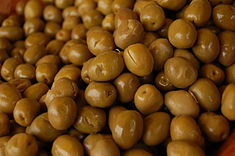 Мариниране зелене маслине | |
| Нутритивна вредност на 100 g (3,5 oz) | |
|---|---|
| Енергија | 609 kJ (146 kcal) |
3,84 g | |
| Шећери | 0,54 g |
| Прехрамбена влакна | 3,3 g |
15,32 g | |
| Засићене | 2,029 g |
| Мононезасићене | 11,314 g |
| Полинезасићене | 1.307 g |
1,03 g | |
| Витамини | |
| Витамин А екв. | (3%) 20 μg(2%) 231 μg510 μg |
| Тиамин (Б1) | (2%) 0,021 mg |
| Рибофлавин (Б2) | (1%) 0,007 mg |
| Ниацин (Б3) | (2%) 0,237 mg |
| Витамин Б6 | (2%) 0,031 mg |
| Фолат (Б9) | (1%) 3 μg |
| Холин | (3%) 14,2 mg |
| Витамин Е | (25%) 3,81 mg |
| Витамин К | (1%) 1,4 μg |
| Минерали | |
| Калцијум | (5%) 52 mg |
| Гвожђе | (4%) 0,49 mg |
| Магнезијум | (3%) 11 mg |
| Фосфор | (1%) 4 mg |
| Калијум | (1%) 42 mg |
| Натријум | (104%) 1.556 mg |
| Остали конституенти | |
| Water | 75.3 g |
| |
| Проценти су грубе процене засноване на америчким препорукама за одрасле. Извор: NDb USDA | |
Плод маслине богат је беланчевинама, хлорофилом, сапонинима, воском, смолом, витаминима А, D, K и Е, масним киселинама као што су: олеинска, стеаринска, палмитинска, многим минералима, ензимима и др. У старо време се маслиново уље користило за исхрану, хигијену и улепшавање, осветљење, лечење и у ритуалне сврхе. Витамин Е и олеинска киселина су познати и доказани антиоксиданси. Данас у свету постоји више од 50 врста маслиновог дрвета које се гаји широм света управо због производње уља или течног злата као се врло често назива.
Лист маслине
Од листа маслине припрема се чај који помаже код упала и тегоба функционисања уринарног тракта.[31]
Маслиново уље
Плод је богат уљем, који се цеди кориштењем притиска кроз разне пресе (хладно цеђено уље), или се издваја користећи врућу воду или пару. Уље се користи у исхрани као додатак јелу, пржење, зачињавање јела, као и у медицинске сврхе. У ранијем периоду су маслине цеђене ручно или уз помоћ камена.

Маслиново уље се цеди индустријски машинама а почетком двадесетог века је то рађено постројењем на водени погон слично воденици.
Маслина у књижевности и историји
У Библији спомиње се више од хиљаду пута. У хришћанству је симбол Божје бриге за људе. Мојсије је ослобађао ратовања мушкарце, који су гајили маслине. Голубица која се после потопа вратила на Ноеву арку у кљуну је носила маслинову гранчицу као симбол помирења Бога и људи. Са много маслинових ганчица народ је прославио Исусов улазак у Јерусалим. Исус се знојио крвавим знојем на Маслинској гори, окружен мноштвом маслина, а Исусов крст, био је по предању од маслиновог и кедровог дрвета.
Због чврстоће и отпорности, маслина је симбол снаге. Тако је Херкул имао тољагу од маслиновог дрвета, а Одисеј је маслиновим коцем ослиепио Киклопа. Маслина је симбол оданости и верности па је Одисејев и Пенелопин брачни кревет био од пања маслине. Хомер је маслиново уље звао текућим златом. Хипократ је маслиново уље преписивао за више од 60 разних болести. Победницима на Олимпијским играма, на главе су стављали маслинове венце, а за награду су добивали амфоре с маслиновим уљем, које је било тада врло скупо.
Производња
Табела показује производњу плода маслине. Првих девет земаља припадају подручју Медитерана и производња маслина у тим државама чини 95% светске производње (према подацима Fao).
| Година 2003 | Производња (у тонама) |
Обрадива површина (у хектарима) |
Количина изражена у (q/Ha) |
|---|---|---|---|
| Свет | 17 317 089 | 8 597 064 | 20,1 |
| 1. Шпанија | 3 160 100 | 2 400.000 | 25,7 |
| 2. Италија | 6 149 830 | 1 140 685 | 27,6 |
| 3. Грчка | 2 400.000 | 765 000 | 31,4 |
| 4. Турска | 1 800.000 | 594 000 | 30,3 |
| 5. Сирија | 998 988 | 498 981 | 20,0 |
| 6. Тунис | 500.000 | 1 500.000 | 3,3 |
| 7. Мароко | 470.000 | 550.000 | 8,5 |
| 8. Египат | 318 339 | 49 888 | 63,8 |
| 9. Алжир | 300.000 | 178 000 | 16,9 |
| 10. Португал | 280.000 | 430.000 | 6,5 |
| 11. Либан | 180.000 | 230.000 | 4,5 |

Галерија
-
У Црној Гори, у Бару, расте Стара маслина (Olea europaea) чија се старост процењује на преко 2.000 година. Верује се да је ово најстарије стабло маслине у Европи и једно од најстаријих у свету
-
Маслињак
-
плод маслине пореклом из Јордана (Мртво море)
-
Илустрација маслине из 19. века
-
млада биљка
-
лице и наличје листова
-
пре цветања
-
цветање
Види још
Референце
- ^ Magos Brehm, J.; Draper Munt, D.; Kell, S.P. (2011). „Olea europaea (errata version published in 2016)”. The IUCN Red List of Threatened Species 2011. e.T63005A102150835. Приступљено 26. 6. 2021.
- ^ „Kew World Checklist of Selected Plant Families, Olea europaea”. Royal Botanic Gardens, Kew. Приступљено 5. 12. 2014.
- ^ „Olea europaea (map)”. Biota of North America Program. Приступљено 5. 12. 2014.
- ^ Eddo Rugini; Luciana Baldoni; Rosario Muleo; Luca Sebastiani (2016). The Olive Tree Genome. Springer. стр. 14. ISBN 978-3-319-48887-5.
- ^ Apostolos Kiritsakis; Fereidoon Shahidi, ур. (2017). Olives and Olive Oil as Functional Foods: Bioactivity, Chemistry and Processing. John Wiley & Sons. стр. 129. ISBN 978-1-119-13531-9.
- ^ Susan Featherstone (2015). A Complete Course in Canning and Related Processes: Volume 3 Processing Procedures for Canned Food Products. Woodhead Publishing. стр. 113. ISBN 978-0-85709-687-6.
- ^ Green PS (2002). „A revision of Olea L. (Oleaceae)”. Kew Bulletin. 57 (1): 91—140. JSTOR 4110824. doi:10.2307/4110824.
- ^ Besnard G, Rubio de Casas R, Christin PA, Vargas P (2009). „Phylogenetics of Olea (Oleaceae) based on plastid and nuclear ribosomal DNA sequences: Tertiary climatic shifts and lineage differentiation times”. Annals of Botany. 104 (1): 143—160. PMC 2706730
 . PMID 19465750. doi:10.1093/aob/mcp105.
. PMID 19465750. doi:10.1093/aob/mcp105.
- ^ „Genetic characterisation of olive trees from Madeira Archipelago using flow cytometry and microsatellite markers”. Genetic Resources and Crop Evolution. 2008.
- ^ Marone, Elettra; Fiorino, Piero (јануар 2012). „Oleiculture in progress”. Advances in Horticultural Science. 26 (3–4). doi:10.13128/ahs-22672.
- ^ Besnard G, Garcia-Verdugo C, Rubio de Casas R, Treier UA, Galland N, Vargas P (2008). „Polyploidy in the Olive Complex (Olea europaea): Evidence from Flow Cytometry and Nuclear Microsatellite Analyses”. Annals of Botany. 101 (1): 25—30. PMC 2701839
 . PMID 18024415. doi:10.1093/aob/mcm275.
. PMID 18024415. doi:10.1093/aob/mcm275.
- ^ „Buah Ca-na, Chinese White Olive”. Singapore National Parks Board (на језику: енглески). Приступљено 2019-02-14.
- ^ а б World Olive Encyclopedia, International Olive Council, 1996, ISBN 978-8401618819
- ^ Lanza, Fabrizia (2012). Olive: A Global History. Reaktion Books. стр. 106—110. ISBN 978-1-86189-972-9.
- ^ Garrido Fernandez, A.; Fernandez-Diez, M.J.; Adams, M.R. (1997). Table Olives: Production and Processing. Springer. стр. 23—45. ISBN 978-0-412-71810-6.
- ^ а б Boskou, D., ур. (1996). Olive Oil. Chemistry and Technology. AOCS Press.
- ^ Therios, Ioannis Nikolaos (2009). Olives: Volume 18 of Crop Production Science in Horticulture (History of Olive Growing, page 1). CABI. ISBN 978-1-84593-620-4.
- ^ Marquer, L.; Otto, T.; Arous, E. Ben; Stoetzel, E.; Campmas, E.; Zazzo, A.; Tombret, O.; Seim, A.; Kofler, W.; Falguères, C.; El Hajraoui, M. Abdeljalil (2022-03-22). „The first use of olives in Africa around 100,000 years ago”. Nature Plants (на језику: енглески). 8 (3): 204—208. ISSN 2055-0278. doi:10.1038/s41477-022-01109-x.
- ^ Kislev et al. 1992
- ^ Besnard et al. 2002,2013b
- ^ Lumaret et al. 2004
- ^ Baldoni et al. 2006
- ^ Diez et al. 2015
- ^ Thompson, John D. (2020). Plant Evolution in the Mediterranean: Insights for Conservation. Oxford University Press. ISBN 9780198835141.
- ^ Di Giovacchino, Luciano (2013). „3”. Handbook of Olive Oil: Analysis & Properties (2nd изд.). New York: Springer Science & Business Media. стр. 57.
- ^ а б Vossen, Paul (2007). „Olive Oil: History, Production, and Characteristics of the World's Classic Oils”. HortScience. 42 (5): 1093—1100. doi:10.21273/HORTSCI.42.5.1093
 .
.
- ^ Lanza, Fabrizia (2011). Olive: a global history. London: Reaktion Books. стр. 15. ISBN 978-1-86189-972-9.
- ^ Gooch, Ellen (2005). „10+1 Things you may not know about olive oil”. Epikouria Magazine (Fall/Spring). Архивирано из оригинала 8. 12. 2014. г. Приступљено 5. 12. 2014.
- ^ Friedrich W.L. (1978). Fossil plants from Weichselian interstadials, Santorini (Greece) II, published in the "Thera and the Aegean World II", London, pp. 109–128. Retrieved on 2011-12-07.
- ^ „Mediterranean Museums of Olive”. www.oliveoilmuseums.gr. Архивирано из оригинала 2016-02-08. г. Приступљено 2016-05-22.
- ^ „Чај листа маслине”. Приступљено 04. 03. 2017.
Литература
- Гостушки, Р: Лечење лековитим биљем, Народна књига, Београд, 1979.
- Грлић, Љ: Енциклопедија самониклог јестивог биља, Аугуст Цесарец, Загреб, 1986.
- Дјук, А, Џ: Зелена апотека, Политика, Београд, 2005.
- Јанчић, Р: Лековите биљке са кључем за одређивање, Научна књига, Београд, 1990.
- Јанчић, Р: Ботаника фармацеутика, Службени лист СЦГ, Београд, 2004.
- Јанчић, Р: Сто наших најпознатијих лековитих биљака, Научна књига, Београд, 1988.
- Којић, М, Стаменковић, В, Јовановић, Д: Лековите биљке југоистичне Србије, ЗУНС, Београд 1998.
- Лакушић, Д: Водич кроз флору националног парка Копаоник, ЈП Национални парк Копаоник, Копаоник, 1995.
- Марин, П, Татић, Б: Етимолошки речник, ННК Интернационал, Београд, 2004.
- Миндел, Е: Витаминска библија, ФаМилет, 1997.
- Мишић Љ, Лакушић Р: Ливадске биљке, ЗУНС Сарајево, ЗУНС Београд, ИП Свјетлост, 1990
- Стаменковић, В: Наше нешкодљиве лековите биљке, Тренд, Лесковац
- Туцаков, Ј: Лечење биљем, Рад, Београд, 1984.
Спољашње везе
- Маслина, РТС Квадратура круга - Званични канал
- Јестива историја: Маслина, РТС Образовно-научни програм - Званични канал
- Bionet škola
- Blue planet biomes: Olive trees — Olea europaea — cultivation history + horticulture.
- Agricultural Research Service (ARS); Germplasm Resources Information Network (GRIN): Olea europaea — species treatment, native range, + links.
- USDA Plants Profile for Olea europaea ssp. europaea (European olive)
- USDA Plants Profile for Olea europaea ssp. cuspidata (African olive)
- Olive trees (Olea europaea) — U.C. Photo gallery
- Olives на сајту Curlie
 „Olive”. Encyclopedia Americana. 1920.
„Olive”. Encyclopedia Americana. 1920.- Olea europaea ssp. europaea (Olive Scientific Information)
- Reproduction of the olive tree Архивирано на сајту Wayback Machine (13. јун 2017)
- Agricultural Research Service, US Department of Agriculture; Germplasm Resources Information Network (GRIN): Olea europaea
- Most Common Spanish Olea Trees, Ginart Oleas


